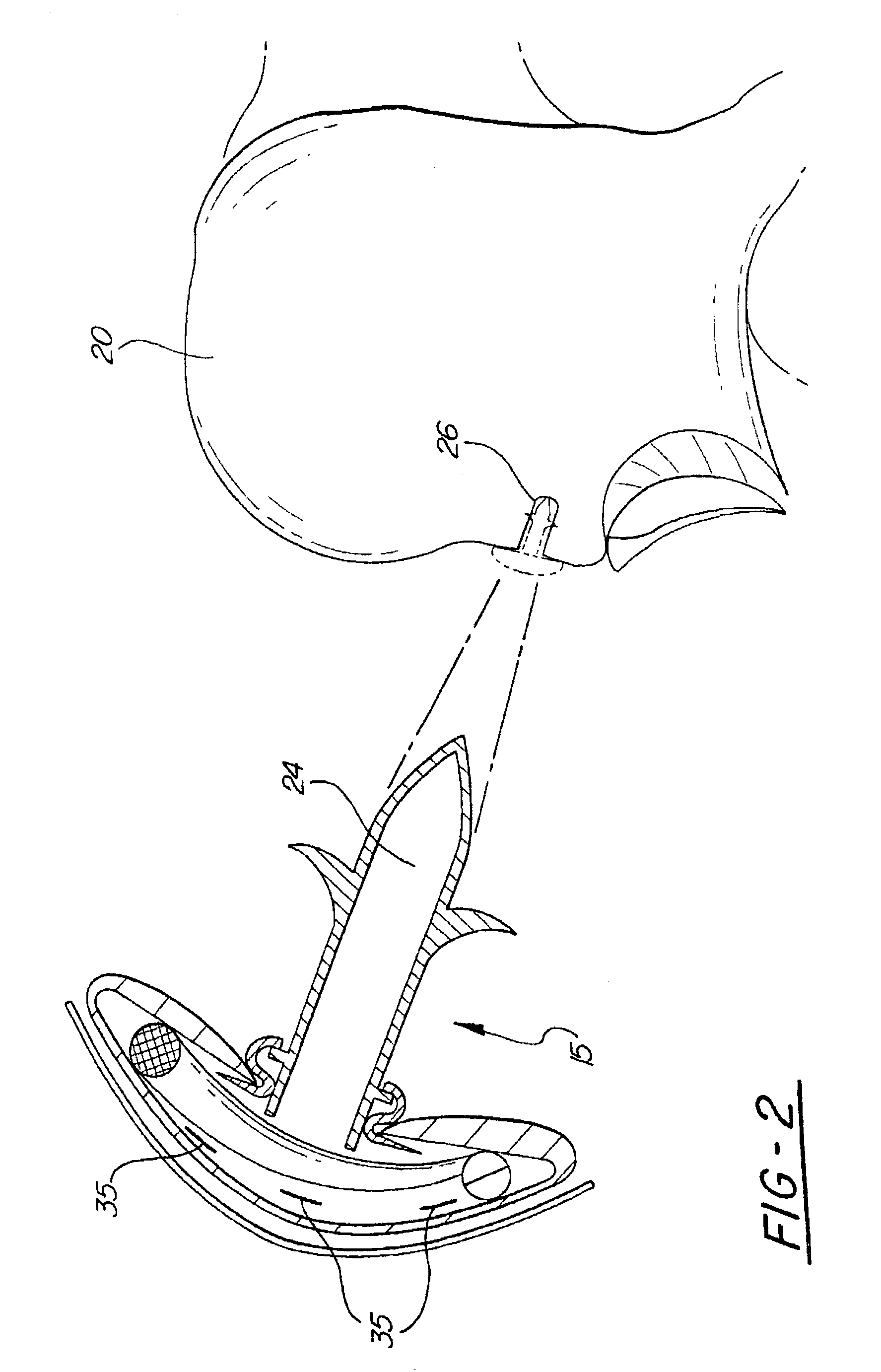[0014]External beam
irradiation establishes
therapeutic effectiveness. The directional-ionizing energy emitting implant device of the present invention is for attachment either to natural tissue or a prosthetic device, and delivers a prescribed dosage of energy to targeted tissue. The implant device includes an energy-source material that delivers the prescribed dosage of energy to the targeted tissue, while minimizing
exposure of nontargeted tissue. The targeted tissue has a known profile and is adjacent to the targeted tissue. The energy-source material in combination with the prosthetic device defines an actual energy-delivery distribution field. The energy-delivery distribution field has a configuration similar to the known profile of the targeted tissue. The prescribed dosage of energy is applied from energy-source material within the insert device and directed to the targeted tissue. The prescribed energy dosage is determined by using known characteristics of the energy-source material, and by the placement of the energy-source material relative to the targeted tissue. The implant
system reduces the occurrence of
heterotopic ossification caused by the implant, inhibits growth or migration of benign or malignant living cells, and minimizes or even eliminates infectious processes or delayed
keloid or scar formation induced from surgical placement of a functional
prosthesis or fixation device, in tissue within or about the device due to its targeted
radiation effects.
[0015]The present invention is a directional-ionizing energy emitting implant device and a method for delivering a dosage of
radiation to targeted tissue. The
system comprises a prosthetic device that functionally replaces or is additive to a body structure or joint, and radio source material. The radio source material is positioned either on or within the prosthetic device. The actual radiation delivery distribution field has a similar configuration to the profile of the targeted tissue. The implant system is particularly useful to minimize or even eliminate infectious or inflammatory processes or delayed
keloid or scar formation induced from surgical placement of a functional
prosthesis or fixation device in tissue within or about the device due to its targeted radiation effects.
[0016]When such therapy is delivered within a narrow period of time, the prophylactic use of
external beam radiation therapy demonstrates an effective reduction of the incidence and severity of
heterotopic ossification. A limited, relatively low-
dose of focal
ionizing radiation to the specific
target tissue, when administered predominantly in the first several hours to two days after
surgery has proven beneficial clinical results with virtually no short or long term side effects.
[0019]The directional-ionizing energy emitting implant device and method of the present invention offer numerous medical, safety and economic advantages over conventional radiotherapy. The structure of this system dramatically improves the delivery of the radiation to the targeted tissue as compared with the non-targeted tissue, inherently accommodating for individual patient differences in morphology. Improved radiation
efficacy is achieved by delivering a continuous
dose rate of radiation and by utilizing known characteristics of various radio nuclides; such as half-life,
specific activity, specific concentration, and type of energy decay.
[0020]The artificially implanted apparatus is functionally replacing or is additive to a normal anatomic body structure or joint. The apparatus is implanted, imbedded, or contained in a housing for strategically localized
solid, liquid, gel-like, gaseous, or other intermediate phase radio-emitting substance or capable of inducing
ionizing radiation,
phosphorescence,
luminescence, or
fluorescence; whereby a precalibrated general or specific
total dose,
dose rate, or
depth dose is delivered to adjacent
target tissue to inhibit growth, migration, or differentiation of benign or malignant living cells; to inhibit heterotopic
ossification; and to minimize infectious or inflammatory processes or minimize delayed scar or keloid formation in such tissue.
[0021]Since the radiation only travels a
short distance within the patient's
soft tissue and essentially only through the targeted area, there is minimal
radiation risk to medical personnel and
healthy tissue within the patient. Such radiation may begin its effective delivery immediately at the time of the procedure or is activated in
delay post-operatively and over the immediate
critical time frame for heterotopic
ossification formation and / or minimize infectious, inflammatory, or scarring processes in such tissue. The radio
nuclide dosage eventually decays to a non-radioactive state thereby enabling healing and without
functional impairment to the prosthesis or fixation devices. The patient is discharged after
recovery and receives the equivalent radiation benefit of several fractionated external beam treatments without the time, inconvenience, discomfort, and expense of conventional radiotherapy, while minimizing
exposure to nontargeted tissue. Also, the system and method of the present invention promote more routine use of prophylactic radiation to prevent heterotopic
ossification and minimize infectious, inflammatory, or scarring processes in such tissue by enabling potential broader physician access, flexible treatment judgments, and less patient pain and inconvenience.
 Login to View More
Login to View More  Login to View More
Login to View More 


